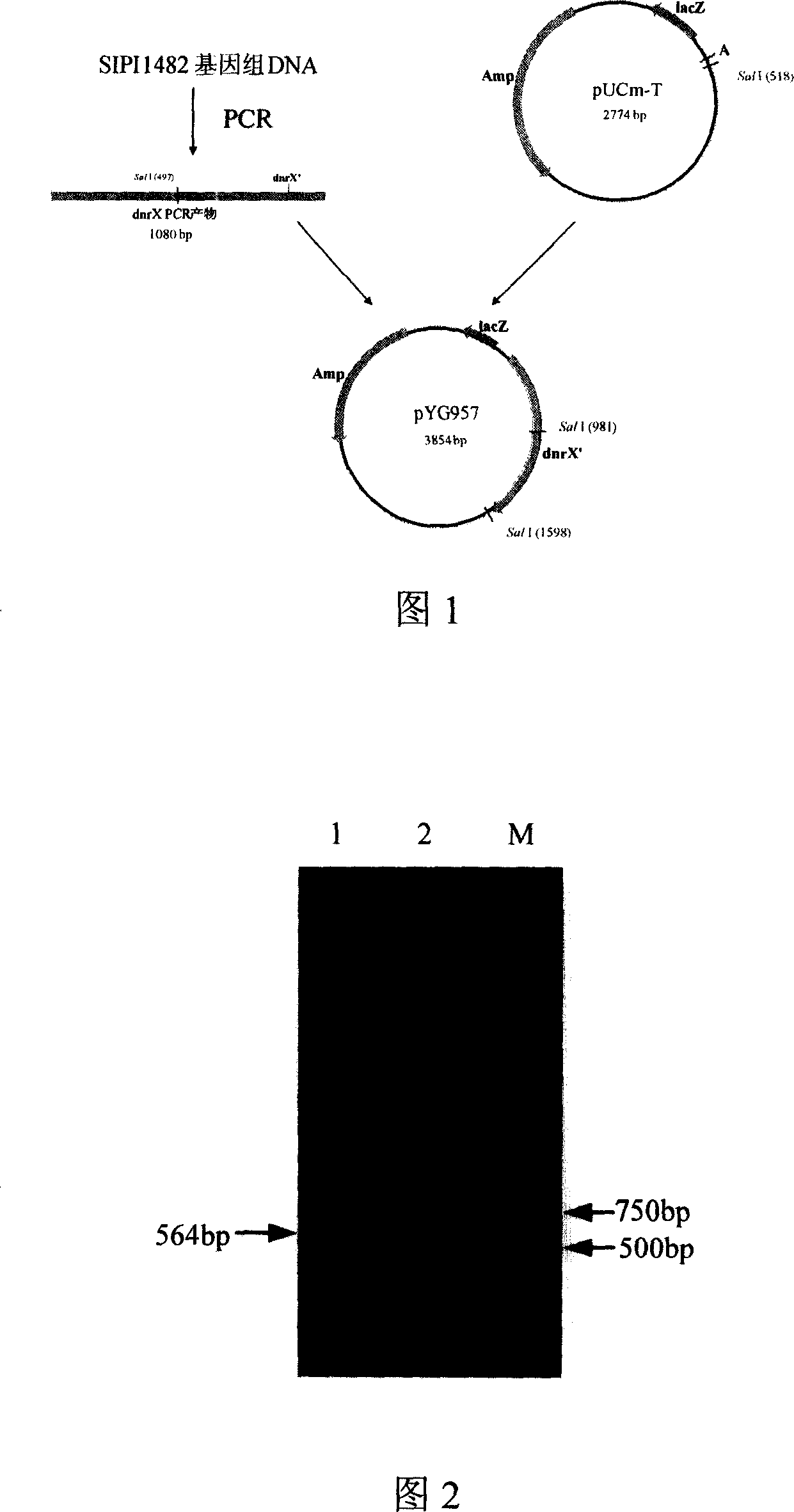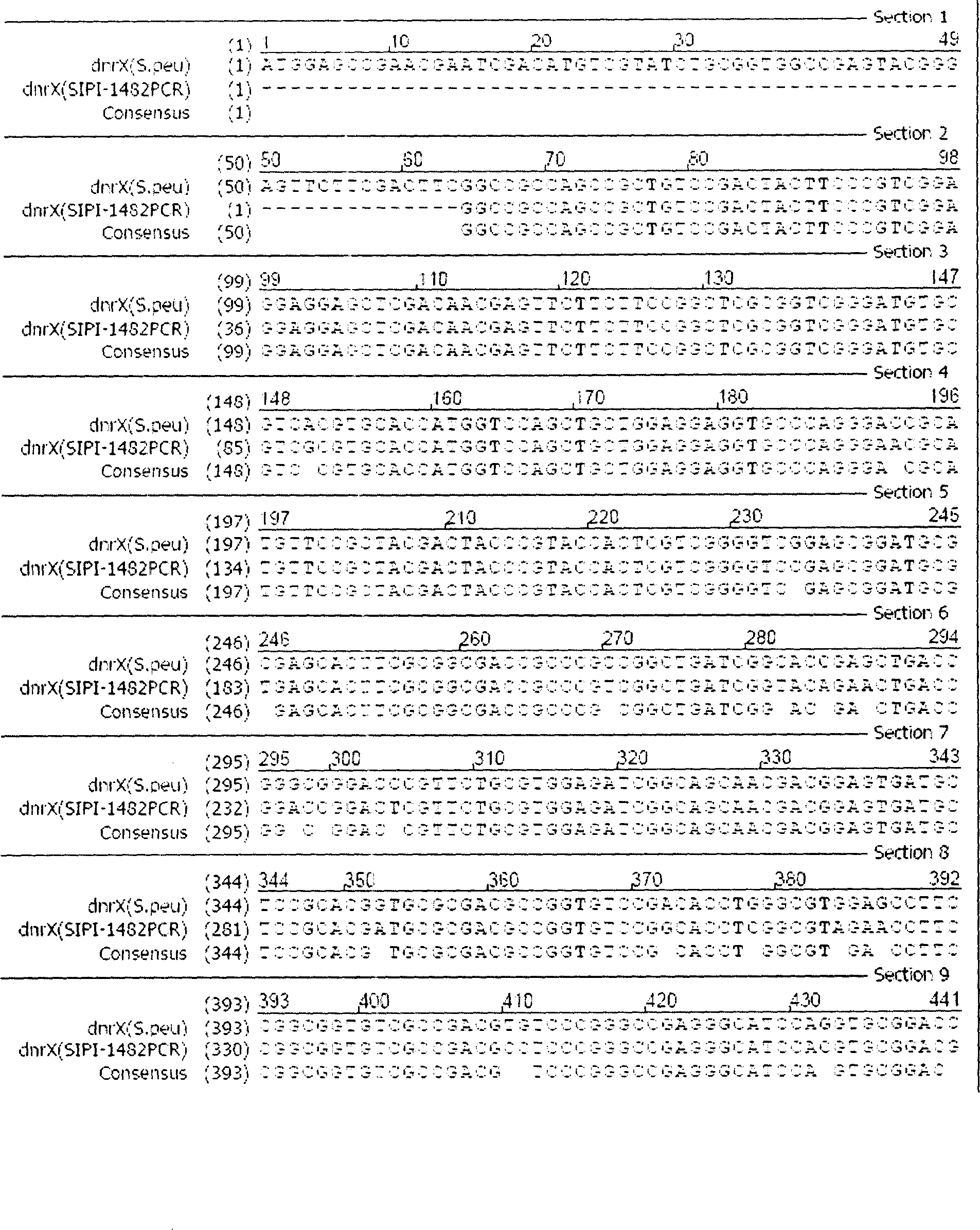Anthracene nucleus antibiotic producing strain dnrX gene fragment, gene breaking engineering bacterium prepared from the same and application thereof
A gene fragment and antibiotic technology, applied in the field of genetic engineering, can solve the problems of low conversion rate, complex process, environmental pollution, etc., and achieve the effect of increasing yield
- Summary
- Abstract
- Description
- Claims
- Application Information
AI Technical Summary
Problems solved by technology
Method used
Image
Examples
Embodiment 1
[0032] Embodiment 1 PCR amplification dnrX' gene
[0033] Since only the dnrX gene sequence (accession number AF048833) derived from the daunorubicin-producing strain Streptomyces persei ATCC29050 has been published in GenBank, and there is no relevant report on the gene sequence outside the final codon. Given that the purpose of amplifying the gene is to block mutations, an incomplete gene can be amplified. Based on this, primers dnrX1 and dnrX2 were designed.
[0034] dnrX1 sequence: 5'-GGCCGCCAGCCGCTGTCCGA-3' (SEQ ID No.5)
[0035] dnrX2 sequence: 5'-GTGGTTCCAGGCGAAGAGCAGCGCATAGTC-3' (SEQ ID No.6)
[0036] PCR amplification was performed using the SIPI-1482 genome of S. coeruleorubidus as a template, and the reaction system was shown in Table 1:
[0037] Table 1 PCR reaction system composition
[0038] components
Final concentration
Dosage (μl)
10X reaction buffer MgCl 2 (15mmol / L)
5'-primer (10μmol / L)
3'-primer (10μmol / L)
Template...
Embodiment 2
[0042] Preparation and sequencing of the gene fragment dnrX" of embodiment 2dnrX'
[0043] The plasmid pYG957 was digested with Nco I, and the large fragment was recovered for self-ligation, transformed into DH5α competent cells, and the intermediate plasmid pYG962 was constructed (as shown in FIG. 4 ). The intermediate plasmid pYG962 was digested with KpnI and HindIII for verification, and pYG957 was digested with KpnI and HindIII for comparison. As shown in Figure 5, two bands of 1203bp and 2651bp were obtained by double enzyme digestion of pYG962, and two bands of 1080bp and 2651bp were obtained by double enzyme digestion of pYG957. , proving that the plasmid is correct.
[0044] Then, dnrX" was obtained by digestion with KpnI+HindIII from plasmid pYG962. The measured sequence is shown in SEQ ID No.3 in the sequence listing, and the encoded amino acid sequence is shown in SEQ ID No.4.
Embodiment 3
[0045] Example 3 Construction and Verification of Destroying dnrX Using Single Exchange to Block Mutation Plasmid pYG963
[0046] The dnrX" gene fragment obtained from plasmid pYG962 digested with KpnI+HindIII and the apramycin resistance gene apr (GenBank accession number: AJ566337, commercially synthesized by Yingjun Company) were connected to the vector pBluescript2KSM and constructed into recombinant plasmid pYG963 (As shown in Figure 6), transform DH5α competent cell, screen transformant with apramycin and ampicillin resistance.Extract plasmid and carry out PCR verification and enzyme digestion verification, as shown in Figure 7.With dnrX1 and dnrX2 as primer PCR, the partial gene dnrX' (1080bp) that can be amplified to dnrX gene with plasmid pYG957 as template, but can't with pYG963, as shown in Figure 7 (A), accords with expected result.With the total on the original vector and insert The pYG963 digestion site Sal I was verified by pYG963, and the bands of 4689bp and 61...
PUM
 Login to View More
Login to View More Abstract
Description
Claims
Application Information
 Login to View More
Login to View More - R&D
- Intellectual Property
- Life Sciences
- Materials
- Tech Scout
- Unparalleled Data Quality
- Higher Quality Content
- 60% Fewer Hallucinations
Browse by: Latest US Patents, China's latest patents, Technical Efficacy Thesaurus, Application Domain, Technology Topic, Popular Technical Reports.
© 2025 PatSnap. All rights reserved.Legal|Privacy policy|Modern Slavery Act Transparency Statement|Sitemap|About US| Contact US: help@patsnap.com



